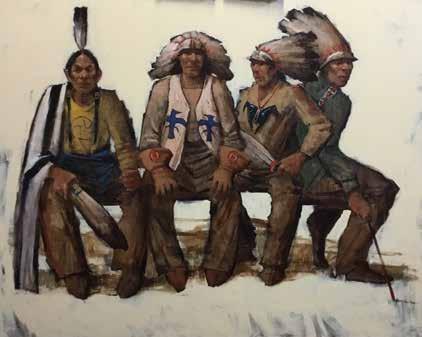
4 minute read
Expressions of Indigeneity: MIKE LARSEN
By Roxanne Beason
Having painted for over 50 years, Mike Larsen has retained his drive to create works that highlight a lifetime of personal innovation. In his adolescence, Larsen knew he had always gravitated towards making art, having always drawn as a kid. Not until exploring and expanding in different art mediums in college at Amarillo Community College and the University of Houston did he decide to major in art and make painting and sculpture as a definitive career choice. Spending time at the Art Institute at New York inspired his self-determination to paint every day and make art a full-time business. He explained that influence on his style came from spending hours at the Metropolitan Museum of Art and analyzing works by impressionist painters, particularly Van Gogh, for capturing the subtly in gesture rather than detail. He stated, “Not that it shows up in my work …but sometimes I think I learned [how to paint] more at the museum.” As a proud member of the Chickasaw Nation, Mike Larsen utilizes painterly expressionism to capture Indigeneity in Oklahoma and beyond.
Larsen explains that, throughout his career, his paintings have become less crowded with detail and more streamlined in design. As an example, instead of capturing every single bead on his model’s traditional Native clothing, Larsen impressively captures the light and movement with gestural paint strokes. He states, “Over the years, I have discovered that you can do much more with a brushstroke than you can with a lot of detail.” Much of his work focuses on Indigenous people, particularly plains tribes. Larsen’s models are from several different tribes, and he poses them in their most impressive traditional attire. Fellow artist Harvey Pratt (Cheyenne/ Arapaho) has made a repeated appearance as a model in Larsen’s paintings.
Additionally, since 2005, Larsen has been a significant part of a project that includes painting and interviewing 72 living Chickasaw elders as a mode of cultural preservation and resilience. Larsen further explained, “art serves that purpose…to preserve history.” Much of his work has been an effort to make expressive accounts for Chickasaw traditions that existed before removal.
One of his paintings, entitled, The Council, shows how his style focuses on the models and their subtle expressions over placement and context. Leaving the background white, four men in their traditional dress sit on a bench together and gaze toward the viewer in their conference. Sitting in wide-leg positions, all the men seem to present their tribal leadership with masculine inclination. The figure furthest on the right has placed down a stick that creates a clear barrier between the viewer and this gathering of men. Us, as viewers, have interrupted, and we are uninvited to this meeting. Yet the juxtaposition of the figures does not seem to allude that they are convening with each other either. This work is a perfect example of
how Larsen has “simplified” his paintings— using a stark, blank background, but focusing on the expressions of the depicted figures instead.
Another piece that shows Larsen’s talent for both skyscapes and movement is seen in his work, Chasing the Dawn. Three Indigenous men ride galloping horses through a field right as the sun is rising. The man leading the party is pointing forward, which signals that they have a clear mission for the morning hour. Larsen beautifully captures the bright pink clouds reflecting the sun against the dark periwinkle sky. As the sun rises, colorful hues gleam from the rider’s faces as well as the shine of their horses. This work especially shows Larsen’s talent for subtle expression with light and color in his painting style, though still retaining the integrity of the scene and traditions of Indigenous people.
Showcasing Mike Larsen’s incredible career, the Goddard Center in Ardmore, Oklahoma, will display around 70 of his paintings. Curated by Cory Blankenship, the show will have a diverse mix of subjects that Larsen has painted throughout his career, including portraits of Indigenous people, skyscapes, imagery featuring horses and buffalo, as well as other still life works. Mike Larsen’s showcase exhibition at the Goddard Center will be on view from September 1 st through October 30 th . For more information, visit goddardcenter.org. n
Roxanne Beason is an art history graduate student at Oklahoma State University. Her studies are focused in contemporary art, art of the American West, and indigenous art. You can reach her at roxanne.beason@gmail.com

TOP: Mike Larson, After Glow, 2020, acrylic on canvas, 8” x 10” BOTTOM LEFT: Mike Larson, Lovely Chickasaw Girl, 2020, acrylic on panel, 20” x 16” BOTTOM RIGHT: Mike Larson, Early Morning Light, 2019, acrylic on panel, 12” x 16”












